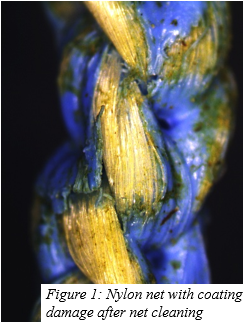REDUCING MICROPLASTIC RELEASE DURING CLEANING OF AQUACULTURE NETS
Aquaculture uses large amounts of plastic for infrastructure and equipment, which likely contributes to microplastic (MP; <5 mm) release to the environment. In addition to feed pipes and cage collars, pen nets are a potential source for MP release. In-situ net cleaning, typically conducted using dedicated pressure washers, may exacerbate abrasion of nets and their coatings, leading to higher MP emissions during cleaning periods. As a result, fibres, as well as synthetic particles from net coatings, may be dispersed into the surrounding seawater.
A laboratory experiment simulating abrasion damage from net cleaning was performed to quantify and compare the relative amounts of MP released from common nylon nets and alternative net materials (HDPE, Dyneema, Entex), applying both new and used net samples. In addition, net samples with two different coatings, used to extend the material lifetime, were included. The abrasion tests were conducted using abrasion equipment from Buraschi, where the nets were subjected to a rotating abrasive drum in a water tank. Particles released into the water were washed and filtered (≥10 µm) before being quantified and physiochemically characterised using a combination of gravimetric measurements, microscope imaging and chemical fingerprinting by pyrolysis GC-MS.
Results indicated higher MP release from the nylon nets compared to the HDPE, Dyneema and Entex nets. Coatings interacted differently with the various net materials, where there was no change in MP release from the coated Dyneema nets, but an increased particle release from the coated nylon nets. Used materials released more MP than new ones.
Based on these results, used nylon nets and new nylon nets with coating were chosen for an accelerated net cleaning test, conducted in full scale at sea. Here, we simulated 10 months of in-situ cleaning. Two novel cleaning technologies, cavitation-based cleaning and AUV based brushing, were compared to standard high-pressure based cleaning. The release of MP into the surrounding seawater, as well as abrasion of the coating from nets (Figure 1), were assessed. The MP release was determined using a combination of onsite filtration of seawater during the cleaning processes, and subsequent analysis of the retained particles by µFTIR spectroscopy to determine particle number, size distribution and polymer type.
To validate the results, we also sampled MP from seawater during a set of regular net cleaning events conducted with high-pressure washers at a commercial salmon farm site. Finally, we have modelled release from net cleaning based on the collected data (Figure 2) for different combinations of net materials, coatings, life stages and cleaning technologies to give the aquaculture industry a first indication of which material, coating and cleaning technology combinations may minimise current MP releases to the marine environment. These findings underscore the potential of material selection and maintenance practices in reducing the environmental impact of aquaculture operations.
Acknowledgement
The work is part of the project “Surveying microplastic release from aquaculture nets and ropes using different technologies for emission reduction (SMARTER)”, funded by the Norwegian Seafood Research Fund (FHF).

